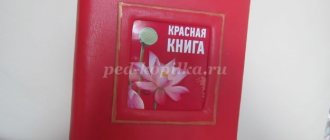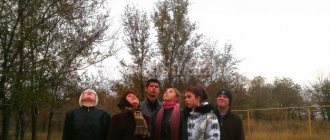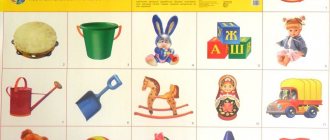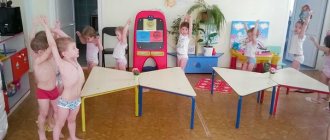The ABCs of health in kindergarten. project (senior group) on the topic
The ABCs of health in kindergarten.
(educational projects “Me and my body”, “Clean palms”, “Soup soup and porridge is our food”, “The world around us”.)
Information and pedagogical experience in developing health-saving competence for children of senior preschool age through cognitive and research activities “The ABC of Health.”
The goal of this project is to generalize innovative experience and create a training system for children of senior preschool age, aimed at creating optimal conditions for preserving and strengthening the health of children, developing health-preserving competence as part of a universal culture, representing the totality of a person’s holistic attitude to health. To achieve this goal, the “ABC of Health” program was designed to develop the health-saving competence of children of senior preschool age through cognitive and research activities. When organizing the educational activities of a teacher with children, conditions are created for strengthening and preserving health, increasing the level of health-preserving competence through the use of methods and techniques of cognitive and research activities.
One of the modern methods of creating a culture of children's health is the project method. In the process of working on the long-term project “The ABC of Health”, I developed and implemented educational projects “Me and my body”, “Clean palms”, “Shchi and porridge is our food”, “The world around us”.
Mini project “Clean Palms”.
Project goal: Formation of experience in health-saving activities and the foundations of a healthy lifestyle.
Objectives: 1. To strengthen a conscious attitude towards the daily routine and cultural and hygienic norms and rules.
2. Improve understanding of the algorithm of basic hygienic processes, increase the quality requirements for independently performed cultural and hygienic actions, and achieve their accurate and precise implementation.
3. Form the habit of always being neat, noticing problems in your clothes, and correcting them yourself or with the help of an adult.
4. Develop self-control when following the rules and regulations of personal hygiene.
Project product: creation, together with children, of visual models “Cleanliness Rules”, “Good and Bad Habits”.
For the successful implementation of the project, activities were planned for the joint activities of children, parents and teachers).
At the beginning of my work with children, I used “The Tale of Microbes”, invited the children to think about what is true and what is fiction in the fairy tale, and clarified what helps us defeat germs; Together with the children, we modeled the sequence of performing hygienic actions (with the help of conventional signs, a diagram is drawn up - a step-by-step map), then the children performed them independently. The practical task “Bad Advice” (draw a person who performed “Harmful Advice” based on G. Oster’s poem) helped children understand the need to perform cultural and hygienic procedures. In solving problems of developing cultural and hygienic skills, I use a number of techniques: the hygienic workshop method. Exercises with performing actions during didactic and role-playing games; educational game situations, a systematic reminder of the need to observe hygiene rules and a gradual increase in requirements for them, a combination of playful, verbal and visual teaching methods using special sets of materials on hygienic education in kindergarten, and a variety of story-based pictures. Games “Journey to the land of cleanliness”, “Rules of cleanliness”, “Confusion or what’s for what?”, “Journey to the city of personal hygiene”, conversation - workshop “Rules of body care”, solving problem-game situations “Washing hands and care” for nails”, inventing advertisements for hygiene procedures helped children learn to take care of themselves. Group tradition “Meeting interesting people” - honey. sister of the dental clinic Astrova K.V. contributed to children's awareness of the need to brush their teeth daily. Ksenia Vladimirovna invited the children to look at dental models, showed them how to brush their teeth correctly, and read the fairy tale “How to Defeat Caries.”
To bring to the awareness of children the need to perform hygienic procedures, weekly conversations - “five minutes” on the topics: “Personal hygiene” help; “We must, we must wash ourselves”; "Our faithful friends"; “Is it dangerous to be a slob”; “Cleanliness is the key to health”; "Clothing and health." Poems, riddles, stories - riddles, physical education minutes, games and play exercises help make the process of developing skills interesting and unobtrusive. In the game “My Morning”, passing the ball to each other, children tell what we do in the morning. The game exercise “Helpful - Harmful” reinforces knowledge about useful and bad habits. The games “Who can lace up a shoe faster” and “Let’s dress a doll for a walk” help to instill neatness and orderliness in children.
For effective hygienic education and the development of self-control in older preschoolers, we assign orderlies to systematically check the condition of their peers’ nails, hands, clothes, and the contents of personal belongings in the closet. Children's skills become strong if they are reinforced in different situations. The main thing is that children have fun and that they can see the results of their actions.
In older preschool age, to consolidate the acquired ideas about cultural and hygienic skills, self-service skills, I use the developed workbook “Growing Healthy.” Working in a notebook, children complete practical tasks from famous fairy-tale characters.
At the end of the project, musical and educational leisure time “We must, we must wash ourselves in the mornings and evenings” is held, during which children demonstrate the acquired knowledge.
The goal of the “Me and My Body” project is to form the foundations of a healthy lifestyle in children, to achieve conscious compliance with the basic rules of health conservation.
Objectives: 1. Clarify ideas about the characteristics of your body, the purpose of individual organs (eyes, ear, nose, legs, etc.), the conditions for their normal functioning.
2. Develop a conscious attitude towards your health, develop the ability to determine your condition and sensation, and know the individual characteristics of the body.
3. Develop skills in readiness to solve health-saving tasks, in the field of behavior in unforeseen situations and provision of basic medical and psychological assistance: call for help, seek help, listen to instructions from adults, be able to help yourself and others (treat minor scratches, abrasions) , be able to act correctly in case of illness or injury.
Project product: collage “Good and Bad Habits”.
When starting work on this project, we introduce children to a problematic situation: we are trying unsuccessfully to construct a little man out of thick ropes. Children help the teacher, but they fail to impart stability to the person. During their independent search, children find aluminum wire, push it into pre-made holes, and express delight at the constructed rope man. The teacher suggests looking at a color table with a picture of a real human skeleton. Children find the bones of legs, arms, and heads, and then show the state of the body if there were no skeleton inside. Transforming children into kind and angry “kittens” helps us understand that our skeleton is flexible. Then the children make their own “wire man.” As we work, we have a casual conversation about the strength of our skeleton, offer to test the strength of a chicken bone, which is placed between two tables, and hang a load on it. We propose to draw a conclusion about who helps us move. On one of the educational evenings, we tell the children about correct posture, practice pantomimic modeling of the gait of their friends, play games to develop correct posture - “Going to the Zoo”, “Rooster Step”, “Gymnastics for a Hedgehog”, “Oriental Waiter”. We invite children to answer the question “What secrets of their body would they like to know?”
By agreement with the children, we plan to work together, which will allow the child to get to know his body, its capabilities in an entertaining way and feel like a truly amazing person.
We study such topics as “The human body” (body structure), “Cipollino is our guest” (purpose of the senses), “Take care of your health” (prevention of injuries, colds), “A magical country - health”, “The commander of our organism”, “Where did I come from”, “What are boys and girls made of”, “My scouts and smart assistants” (sense organs), “Unusual human clothing” (skin), “My inner kitchen” (internal organs). To attract children's interest in studying the structure of their body, the rules of caring for it, and increasing the effectiveness of the above classes, we include a variety of forms and methods of working with children:
- educational one-day and multi-day trips, riddles about the amazing secrets and wonders of one’s body, hidden and targeted observations of the teacher over children and children at each other, work on solving problem-game situations, games - trainings;
- practical activities for children with color tables, microscope, magnifying glasses.
We dedicate one of the “Now Let’s Find Out” evenings to the main strengths of man – the muscles. We invite children to look at illustrations depicting weightlifters, gymnasts, ballet dancers, we emphasize the beauty of the athletes’ bodies, and we explain what muscles are. We organize the “Barbell” sketch with the boys, and the “Beautiful Icicle” sketch with the girls, then we read A. Dorokhov’s story “The Young Old Man”, discuss with the children why the boy was called that, and what needs to be done in order not to turn into such old men. With children we are learning the poem “Strong Man” by S. Prokofieva. The coach of the children's sports school in archery, B.N. Khramov, senior medical student, was invited to “Meeting with Interesting People.” sister of the preschool educational institution Kovaleva I.I., who introduced the children to sports and first aid techniques in an accessible and interesting way.
In the role-playing game “Hospital” we play out the situations: “Muscle strain”, “Leg fracture”, we introduced children to the rules of behavior in these situations and practical methods of providing assistance, the children were happy to put a splint on a child with a “broken leg”, and with “ “muscle stretching,” a tight bandage, a light massage, “alcohol” rubbing, a cold compress, and transportation by ambulance to a “clinic” for treatment.
Psychophysical training exercises to develop physical well-being skills, “Rubber toy” (the child imagines himself as a rubber toy, closes his eyes, tenses and relaxes his muscles), “Orchard” (children imagine picking apples in the garden), “Memory of movements (the teacher shows several movements, accompanying them with words, children mentally remember all the movements in order, perform them), “Create a dance” (children imagine a TV screen, come up with movements to the music). These exercises help eliminate muscle tension in children in gait, facial expressions, and breathing. In order to increase the functional capabilities of the body and restore its performance, we conduct “Minutes of Health” (breathing exercises, eye exercises, massage of biologically active zones, finger exercises), corrective gymnastics to prevent postural disorders and flat feet.
Massage is a system of techniques of dosed mechanical influence on the skin and underlying tissues of the human body. We teach children to perform stroking, kneading, patting movements in the direction of blood flow - from the periphery to the center. For example, “Rain” back massage, “Rain” hip massage, “Mushroom Rain” body massage, “Washbasin” finger massage, “Sparrow” facial massage, massage of biologically active zones (according to A.A. Umanskaya).
Gymnastics for the eyes consists mainly of fixing vision at various points and some movements of the eyeballs and eyelids. To fix vision, we use signal marks.
Signal marks are pictures, toys hung in different corners of the room, under the ceiling (a ball under the ceiling, a magician on the wall, a matryoshka doll on the opposite side). Children really like exercises such as: “Let’s look for the nesting dolls on the shelves. Where is the nesting doll in the blue sundress? Where is the matryoshka doll in the green sundress? Find a nesting doll in a red sundress.”
Breathing exercises help normalize breathing, strengthen the respiratory muscles, prevent congestion in the lungs, and remove phlegm. Exercises are performed standing, sitting and lying on your back. Children enjoy doing breathing exercises “Towards the Sun”, “Geese”, “Spider”, “Crow” and others.
Spinal stretching exercises help children maintain correct posture and promote flexibility of the spine, which plays a key role in human health.
Therefore, it is important to teach your child to sit and stand correctly and not to hunch over. For this purpose, we invite children to take turns standing at the “flower of health” - a part of the wall without a plinth, with their calves, buttocks, shoulder blades and the back of their heads. Parents, as active participants in the project, took part in the “Good and Bad Habits” leaflet competition.
To consolidate the acquired ideas in children, the workbook “Growing Healthy” is used.
At the end of the project, a performance for children “Kolobok - Ice Side” was held.
The goal of the project “Shchi and porridge is our food” is to formulate the basics of rational nutrition among preschoolers, to promote a culture of health, and to make them aware of health as the main human value.
Objectives: 1. To form in children an idea of the need to take care of their body, the importance of proper nutrition as an integral part of maintaining and strengthening health.
2. Show children that balanced nutrition, especially in our region, is an important factor in health.
3.Give an idea of the need and importance of regular nutrition, adherence to a diet, and the connection between a person’s diet and lifestyle.
4. Form ideas about the basic principles of food hygiene.
5. Develop table behavior skills: sit up straight, do not put your elbows on the table, eat carefully, chew food silently, know how to use cutlery (spoon, fork, knife), napkin.
Project product: Children's newspaper “Long Live, Signor Tomato”, a book of recipes for family healthy cuisine (prepared jointly by children and parents).
Work on this project began with a “letter from Carlson,” who informs the children that he is in the hospital, and the doctor advises him to eat right. Carlson compiled a menu for lunch: cake with lemonade, chips, candy, marshmallows and Pepsi-Cola. We invite children to discuss whether Carlson is right, and what children know about proper nutrition. Together with the children, we answer the question: What would they like to know about balanced nutrition and draw up an action plan for the implementation of the project. When implementing this project, we widely use problem-game situations in our work with children: “We are going to the store” (they choose products and justify their choice), “Place the products on multi-colored tables” (daily diet products, which are used quite often, are rarely present on the table ), “What should not be shared”, “Health Pyramid”, discussion games “Laws of Nutrition”, “Find out a fairy tale” based on works of fiction, dramatization games “Borscht”, “Vegetable Dispute”, “Turnip”, “Pie” , “Porridge from an axe”, solving riddles and crosswords, puzzles. After telling the children a delicious story about jam, we offer creative tasks, for example, coming up with funny stories about how to prepare a salad, fruit drink, compote, or singing and playing “The song about the boy who didn’t dig potatoes, but came running for lunch.” Games - experiments “Guess the taste”, How to make carrot juice”, “Let’s bake cookies”, “Try and find out the name of the porridge” and others make the educational process interesting and entertaining. Together with their parents, the children took part in the exhibitions of works “Gifts of Autumn”. As part of this project, a tasting table was offered to parents.
At the end of the project, a presentation of the “Cookbook for Healthy Family Kitchen” was organized together with children and parents.
The goal of the project “The World Around Us”: To form basic ideas about the environment and its impact on human health.
Objectives: 1. To form, deepen and systematize ideas about natural factors affecting human health.
2. Form a conscious implementation of hardening procedures.
3. Strengthen the ability to prevent and avoid situations hazardous to health.
Project product: Photo album “How the group lives.”
In the process of implementing this project, we help children understand what is useful and what is harmful to the body.
Hardening is one of the main factors affecting human health.
The purpose of hardening is to develop the body’s ability to adapt to certain environmental conditions, which is developed by repeated exposure to one or another factor and a gradual increase in the dosage of this action. In older preschool age, we introduce a new type of hardening - walking on an ice path after a recreational run. For parents we hold “Open Days” and master classes on the use of hardening procedures at home.
In our work with children, we strive to show that clean air and water are the wealth of the country, the sun is a source of heat and light, we talk about the main causes of air and water pollution, measures to protect the environment, and the impact of clean air and water on human health. One of the methods that allows us to give an idea of the role of water, air, and sun in human life is elementary experimentation.
Children like to independently study the properties of air and water and how to purify water using filters. (They are happy to pass contaminated water through a napkin, a piece of gauze, sand.) Educational conversations “Sun, air and water are our best friends”, “How we breathe”, “How the human heart works” help to consolidate knowledge about the natural factors of hardening the body, games “Earth, water, air”, “Droplets go in circles”, “Streams and lakes”.
When organizing work with children under this project, we take into account the regional component. The ecology of our city is closely connected with oil production. When introducing children to the properties of oil, we draw attention to the fact that pipeline ruptures can lead to environmental pollution. Examining a drop of oil that has fallen on a napkin, children conclude that oil is an oily liquid that penetrates deep into the object, it is lighter than water, therefore, forming a film on the water, polluting the water.
Working on a project allows you to use the situational task method in direct educational activities, the advantage of which is the ability to integrate diverse content in one task. Such an activity is built as a chain of tasks, where the designated logic is preserved. So, for example, in the lesson “Where Health Hides,” we tell children an old legend about how a person has been trying to find his health since ancient times. We ask questions: Where do you think health is hidden? What does it mean to be healthy? Together with our children we compare health to the sun. Using the model of the sun, we gradually discover its rays, which signify the factors of a healthy lifestyle. We support interest in activities by experimenting with “Invisible Air”, breathing exercises, games “Advertising Ball”, “Rules of Cleanliness”, and looking at photographs of people who are hardening themselves. Result of the lesson: a smiling sun, because the children found the answer to the question of where the gods hid our health.
Bibliography:
- L.V. Gavryuchin "Health saving technologies in preschool educational institutions." Moscow. 2007
- Program V.G. Alyamovskaya “How to raise a healthy child.” Moscow 1993
- T.N. program Doronova "Rainbow" Moscow. 2012, “From childhood to adolescence.”
- L.G. Peterson “Methodological recommendations: World of discoveries”. Moscow. year 2012.
- N.O. Berezina, T.I. Grizik, T.N. Doronova “Methodological recommendations: Success.” Moscow. 2011.
- V.A. Derkunskaya "Educational field of health." Moscow. year 2012.
- M.M. Bezrukikh, T.A. Filippova, A.G. Makeeva “Talk about proper nutrition.” Moscow. year 2012.
- T. I. Fesyukova “Learning to manage myself.”
- K.Yu. Belaya "How to ensure the safety of preschoolers."
- E.V. Aleksandrova “Health work in preschool educational institutions under the “Island of Health” program.
- T.A. Shorygin “Conversations about health”, “Cautious tales”.
- E.V. Goncharov “Technology of environmental education for children of the senior, preparatory group.” Ekaterinburg. 2002
- "TRIZ in working with preschool children."
- M.A. Fisenko “Life Safety, Middle and Senior Group. Development of activities."
- S.E. Shukshin “Me and my body.” Moscow. 2004
- N.N. Lukonin "Physical holidays in kindergarten."
- L.G. Gorkov “Scenarios for classes on environmental education of preschoolers.” Moscow. 2007
- O.V. Dybin "The unknown is nearby." Moscow. year 2001.
- Magazines “Preschool Education” No. 3-2005, No. 3-2004, No. 10-2003, No. 3-1993.
- L.V. Artyomova “The world around us in didactic games.” Moscow 1992.
- M.Yu. Kartushina “Green Light of Health” Moscow 2007.
- N.I. Krylova “Health saving space in preschool educational institutions” Volgograd 2008.
- V.R. Druzhinina, Paranicheva T.M. “The daily routine of a child – a preschooler.”
- M.A. Pavlova, M.V. Lysogorskaya “Health saving system of a preschool educational institution” Volgograd 2012.






